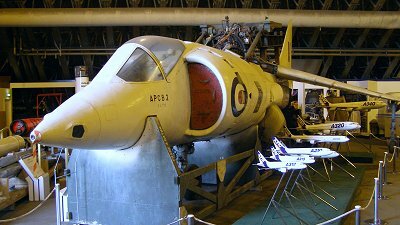| The Harrier airframe arrived at The Museum on 31st October 2012. Thanks to Sharon Webber for the photograph. | ||||
 |
An experimental Harrier Jump Jet airframe, used by Rolls-Royce in the 1980s to test a modified engine for a potential supersonic version, has become the first fixed-wing aeroplane to join the vertical flight collection at The Helicopter Museum. Previously displayed by the Bristol Aero Collection and Rolls-Royce Heritage Trust at Kemble (left) in Gloucestershire, the Harrier arrived at The Museum, by road, late on 31st October 2012 (above) and will be stored until it can be re-assembled to go on permanent display. The test rig used a much modified airframe with the nose and tail of one Harrier (XV798) and the wings of another (XW264), married to a specially-built centre section to house a vectored-thrust Rolls-Royce Pegasus engine, modified with plenum chamber burning (PCB). A form of reheat, whereby fuel is mixed with unburnt oxygen in the engine exhaust to provide a ramjet effect, PCB can double the engine thrust but also results in much higher exhaust temperatures. |
|||
|
It was realised that these very high exhaust temperatures could cause damage to the airframe and wing mounted stores, in addition to the ground surfaces below the aircraft, so trials were carried out at the Ministry of Defence Proof & Experimental Establishment at Shoeburyness, Essex, from 1983, with the Harrier slung from a gantry, to test the effects of PCB under controlled conditions. The use of "toe-in" angle on the two front engine nozzles (photo far right), to ameliorate the effect of PCB on hot gas ingestion, was assessed. The Harrier is still fitted with the framework used to attach it to the gantry (photo right) for the tests.
Chairman of THM Trustees Elfan ap Rees said, in 2012, “Although the proposed supersonic Harrier was never built, the data and lessons learned from this research later found their way into development of the modern-day Lockheed Martin F-35 joint strike fighter (JSF), now on order to replace the Harrier in the Royal Navy. The PCB testbed is therefore an important piece of local aviation heritage and the Trustees have agreed that this fact, coupled with its vertical flight link, makes it well worthy of continued preservation". |
||||